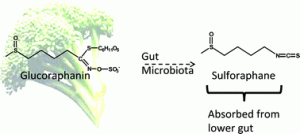Bacteria in the lower gut are responsible for breaking down of the major cancer fighting chemical in broccoli to release its bioactive form, claim Elizabeth Jeffery and colleagues at the University of Illinois.
Cruciferous vegetables such as broccoli have been shown to reduce cancer risks. Of all the components present in crucifers such as antioxidants and flavonoids, it is believed that a molecule called glucoraphanin (GRP) plays a major role explaining their anticancer properties. GRP is actually a precursor to the bioactive isothocyanate sulforaphane (SF). It is hydrolysed to SF by an endogenous enzyme in broccoli called myrosinase. Upon chewing, the myrosinase gains access to the GRP and catalyses hydrolysis within the gastrointestinal tract, however, in cooked broccoli myrosinase is inactivated yet low levels of SF metabolites appear in urine following ingestion, suggesting hydrolysis has, somehow, occurred.
Evidence exists that gut bacteria are responsible for GRP hydrolysis but this study is the first to report direct evidence of hydrolysis of a GRP to SF in the lower gut. Jeffery and colleagues investigated, in rats, the hydrolysis by gut bacteria and absorption across the cecum (lower intestine) of GRP from broccoli. Simulated digestion in vitro confirmed that GRP is not destroyed by digestive enzymes therefore reaches the cecum intact. Introduction of GRP directly to the cecum resulted in the appearance of SF and SF metabolites in the blood travelling away from the abdomen after 2 hours; in contrast, direct introduction of SF resulted in detection of SF and SF metabolites after only 15 minutes.
These results show for the first time that SF can be absorbed by the cecum, they also indicate that GRP is broken down to SF in the cecum and then absorbed into the bloodstream. Finally, an ex vivo study showed that GRP was hydrolysed by the rat’s gut bacteria, however, the hydrolysis product was not SF; reasons for the difference in GRP breakdown in and ex vivo are discussed.
Interested in knowing more? Read the full article here:
Glucoraphanin hydrolysis by microbiota in the rat cecum results in sulforaphane absorption
Ren-Hau Lai, Michael Miller and Elizabeth Jeffery
Food Funct., 2010, DOI:10.1039/C0FO00110D











